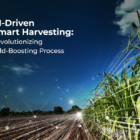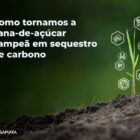You know Brazilian agriculture very well. What is our situation in terms of current technologies and the adoption of technology? How do you assess producers here in Brazil?
I think Brazilian producers, in general, are faster to adopt technologies than farmers in many other countries. This is probably a result of being generally very large. So they are managing sizable businesses and are much more businesses-mind. They really understand the value of technology and how it can contribute to the efficiency and effectiveness of their operations. That is a great advantage that Brazil has. On the other side, problems with connectivity are still present. During the World Agritech South America Summit, I heard one lady mentioning that her farm did not even have 3G. And so it is very difficult to use devices in real time out in the field. This is a barrier to the faster adoption of some of this technology. But I assume that what will happen, by the way, is comparable to many other countries.
For an agtech company, we use to say that if you are not in Brazil, you are not in the market, because of the presence of Brazil in the global market. Do you agree?
I think it is really part of the reason why we see many agtech companies in Brazil. But I have heard that many companies not in Brazil that are doing quite well. China and the East, in general, is a center for agtech. You can see there are lots of activity in China, as well as in India, which is mainly local. I mean, those are major locals, which are developing more for small holders. China is probably farther ahead in drone technology than anywhere else because of its small farmers. Russia and Ukraine are another area where there are much local activity. Local companies are developing more for agriculture in those parts of the world. Their governments are very supportive, particularly in Russia, and are helping to drive progress as well. But it is in their own region where they are willing to invest. Brazil is particularly critical for many companies, but I am learning that there are other key parts of the world too.
There are some investments from big ag companies in technology startups or creating their own digital solutions. Do you think that is a trend? Will these companies also play a key role in digital agriculture or could some small companies challenge big ag in this field?
They are enhancing their positions, that is for sure. Whether they will become the main providers is another question. They have things going on and they have a lot of resources. They also have strong market positions that they can manage right now. Syngenta, my former employer, is in every country in the world and is generally the number one or two company that knows the requirements of all channels and most farmers. It is an established business, so it can bring products and services to the market very easily. On the other hand, they are not entirely unbiased, as the take advantage to help support the sales of their products. For many farmers I think that is somewhat of an issue, but it is also a bit of a complication, because Bayer is offering a proven platform, so is Syngenta, and so are others. How easy is it to use all these different ones? I think that there is a good opportunity for other companies to be the integrator or unbiased platform provider, which could emerge. I also think there is a lot of private equity and many other investors who are betting on that, as well companies such as Syngenta, Bayer, BASF and Corteva. Their core competencies are chemicals and seeds. Ninety nine percent of people working for those companies understand that really well, and digital technology is not their second DNA. Therefore, they need to look at many small companies to create partnerships, which will play a key role for us during that second phase, when we are trying to automate. To be honest, we are working with all those companies on projects that will hopefully become products. They look to us to provide expertise that they do not necessarily want to develop, and we look to them to provide some access to the market.
Let us talk specifically about sugarcane, which is Gamaya’s first product in Brazil. And how do you see this sector here in Brazil? What Gamaya can bring to the sugarcane industry here?
What Gamaya could bring is a lot more efficiency. Sugarcane operations are considerable. There are hundreds of thousands of hectares and to survive, the industry has to be as efficient as possible, which means using the least amount of resources to produce crops. Our first products are more efficiency-oriented ones, helping them decide where they should replant crops, where they should deal with weed infestations, and where they should harvest first. These are operational efficiency improvement products, and I think, in sugarcane, they add considerable value. A farmer estimated that we make back about six hundred dollars per hectare from planting in gaps over the course of the life of the cane. The cost of our product is very low, even too low.
Could you raise it a little bit?
We need to find ways to add value to that. I think it is really interesting, because, from my experience in the crop protection business, our rule of thumb for crop protection is to make sure that farmers make at least three to five times the cost of your chemical in the first year. Otherwise, you do not have a very strong value proposition. I just told you about sugarcane, where we have offer 100 times the return on investment, which is a fantastic opportunity to create money and value for growers. We are trying to ensure that our products are efficient and work properly without significant manual intervention. That is where we are right now.
And soon, you will be involved in soy here in Brazil?
Next year.
What do you predict for soy? I understand that efficiency is also the obvious answer.
Our greatest interest in soybean is nematodes. We are partnering with a company that brings solutions against nematodes, and we are helping that company and farmers find nematodes. One of the relevant challenges is fact that you cannot see them as they are microscopic and hidden in soil, so you will never see them. So you do not really know if spraying is needed or not. This is, therefore, done on speculation or trust while hoping that you will not waste money. So what we are able to do is to paint an accurate picture showing of whether you have nematodes in parts of fields, which will justify precision treatment in only specific areas or on the entire field if there is a major infestation. This will help our partner sell more of their solutions, help farmers realize the benefits of their products, and give them some peace of mind and assure them that they are not spraying where it is not required, for example. They will, subsequently, have a higher probability of getting a return on their investment.
Read the entire article in the following link.
Article written by: Leonardo Gottems, Reporter for AgroPages
Article date: Lausanne, Switzerland – August 21, 2020





